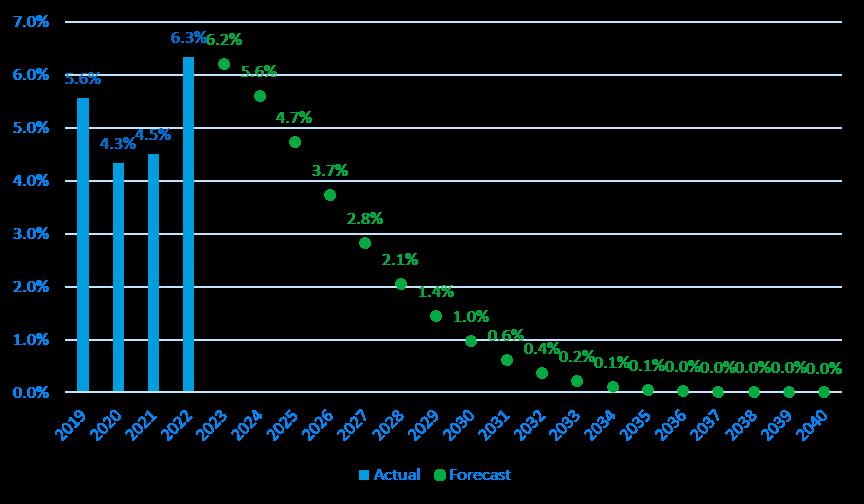Office of Finance
Consolidated Endowment Fund
Environmental, Social, and Governance Report, 2021-22
April 2023


Contents Executive Summary Introduction The Function and Purpose of Pitt’s Endowment Office of Finance Statement of Governance CEF ESG Updates CEF Sustainable Investing Road Map and Future Commitments University of Pittsburgh Office of Finance ESG Report 4 1 6 8 9 11
Executive Summary
The University of Pittsburgh released its inaugural environmental, social, and governance (ESG) Report in March 2022.1 This report, for the fiscal year ended June 30, 2022, is the second edition of what the University plans to release on an annual basis.

The University of Pittsburgh’s largest financial asset is its Consolidated Endowment Fund (CEF), valued at $5.5 billion as of June 30, 2022. The CEF supports financial aid, scholarships, faculty positions, and research activities and links past, current, and future generations of University stakeholders, including students, faculty, and staff.
The primary investment objective of the CEF is to earn a rate of return over an extended period of time that is sufficient to support a prudent spending policy while preserving its inflation-adjusted asset value.
It is the University’s core belief that supporting responsible business practices is integral to producing strong investment outcomes.
This is not a new concept at Pitt. In fact, the Office of Finance, which manages the CEF, has been incorporating many of the concepts now referred to as ESG factors into its due diligence process on a case-by-case basis since 1990. In an effort to reaffirm that commitment and develop a more consistent and comprehensive approach, a formal ESG Policy for the CEF was established in March 2020. 2
1 Available at https://www.cfo.pitt.edu/sites/default/files/esg_report_final.pdf 2 Available at https://www.cfo.pitt.edu/sites/default/files/esgpolicyfinal3-25-20_0.pdf ESG Report University of Pittsburgh Office of Finance 1
This report provides updates on the following topics:
CEF Fossil Fuel Exposure:
Total (public and private) exposure to fossil fuels increased from 5.9% of the CEF as of June 30, 2021, to 8.1% as of June 30, 2022. The increase in total exposure to fossil fuels was primarily attributable to changes in the market value of fossil fuel companies and commodity prices for oil and natural gas and was not the result of new investment activity. Private investment exposure to fossil fuels, which comprised 6.3% of the CEF by value as of June 30, 2022, is currently projected to become de minimis around 2035-36. This forecast is likely to fluctuate significantly over time for reasons outlined in this report.
Policies Regarding Direct Engagement with Underlying Companies and Proxy Voting:
The report provides an overview of the policies governing the University’s direct
engagement with underlying investment holdings regarding ESG matters and its approach to proxy voting.
External Investment Manager ESG Policies:
External investment managers currently overseeing approximately 87% of the CEF by value have formal ESG policies in place or take ESG considerations into account when making investments.
CEF Sustainable Investing Road Map and Future Commitments:
Four commitments were made in the inaugural ESG Report. The Office of Finance has made progress on these commitments since that report was issued, including the launching of an ESG section of the Office of the Senior Vice Chancellor/Chief Financial Officer (SVC/ CFO) website. 3
Recognizing that certain ESG-related factors can have direct financial implications, the University has implemented a more consistent and comprehensive approach to applying ESG factors than in the past. It is hoped that one day there will be a standardized set of industryestablished metrics by which to gauge ESG considerations, and as those standards are developed, the Office of Finance will explore including them in future reports.
It is important to note that this report focuses only on ESG considerations as they relate to CEF investments. The University of Pittsburgh has been actively involved much more broadly in sustainability initiatives for more than 30 years, especially in connection with its operations.

3 Available at https://www.cfo.pitt.edu/divisions/office-finance/environmental-social-and-governance-esg-investment-considerations-pitt
University of Pittsburgh Office of
ESG Report
Finance

ESG Report University of Pittsburgh Office of Finance 3
Introduction
Founded in 1787, the University of Pittsburgh has a mission to provide high-quality undergraduate and graduate programs in the arts and sciences and professional fields while supporting broader public interests contributing to the social, intellectual, and economic development of the Commonwealth of Pennsylvania, the nation, and the world. This mission is future oriented, perpetual in nature, and intrinsically supportive of positive societal and environmental developments beyond the University’s campuses.

4
Pitt’s Consolidated Endowment Fund (CEF) is the University’s largest financial asset, valued at $5.5 billion as of June 30, 2022. The purpose of the CEF is to provide permanent and stable financial support for the benefit of current and future generations of University stakeholders in perpetuity by funding financial aid, scholarships, faculty positions, research activities, and more.

The CEF is governed by the Investment Committee of the Board of Trustees and has been prudently managed by University staff in the Office of Finance within the Office of the Senior Vice Chancellor and Chief Financial Officer. Over the course of the University’s 236year history, community concerns about CEF investment exposures have reached significant levels, prompting reflection and action by the board and Office of Finance staff. In recent years, investment considerations related to fossil fuels have grown in focus among the
University’s stakeholders, including the broader University community (undergraduate and graduate students, faculty, staff, and alumni), the neighborhood of Oakland, the City of Pittsburgh, and the greater Pittsburgh region.
The increased significance of these topics among community stakeholders has coincided and overlapped with a growing investment sector awareness of the potential benefits of considering ESG factors in investment decision making. As explained in Pitt’s ESG Policy, ESG factors include considerations that improve the quality of investment decision making by presenting a deeper and more robust assessment of expected risks and returns. Environmental factors may relate to how a company manages waste or greenhouse gas emissions; social factors may relate to discrimination, data protection or compensation, and retention strategies and policies; and governance factors may relate
to how a company’s senior management is compensated, its succession planning, the compensation of its board of directors, and/ or how shareholder rights are addressed. The Office of Finance has incorporated ESG factors into its investment due diligence process for many years; however, more recently, the Office of Finance staff has done so with a more structured process and an increased focus, diligence, and purpose, as has the institutional investment sector. This increased focus on ESG factors culminated with the release of the inaugural ESG Report in March 2022. 4
4 Available at https://www.cfo.pitt.edu/sites/default/files/esg_report_final.pdf ESG Report University of Pittsburgh Office of Finance 5
The Function and Purpose of Pitt’s Endowment
It is important to review the broader context of the CEF, including why it exists, who governs and manages it, and how it is structured.
What is an endowment?
An endowment is a gift of funds or property whose purpose is to provide the recipient with a source of revenue. Pitt’s endowment is designed to keep the original gift principal intact while using some or all of the resulting investment returns as revenue that financially supports the University’s operating budget, primarily in the form of financial aid for students. The two primary goals of general endowment management are:
1. to preserve the long-term real purchasing power of assets by generating net investment returns that match or exceed the endowment’s annual spending and the eroding effects of inflation and
2. to provide a reliable stream of meaningful revenue for the University.
There is an essential need for universities to invest an endowment’s principal effectively in order to generate sufficient income to provide financial aid, support endowed chairs and professorships, and fund operations, among other uses.
What are Pitt’s endowment characteristics?
The CEF is an investment pool comprising more than 3,000 individual endowment funds, all with designated purposes and restrictions, that are commingled (pooled together) to facilitate more efficient investment. Each endowment fund that the University accepts has a clearly stated, legally binding purpose for the assets provided to which the University must adhere. Additionally, the legal documents accompanying CEF investments typically include confidentiality provisions that prevent the University from disclosing specific investments or investment managers. Confidentiality provisions are deemed necessary to avoid impairing long-term investment returns.
Among CEF objectives, the most critical to the University’s mission is the long-term preservation
Financial Aid
Chairs, Professorships, and Instruction
Postretirement Reserves
Scholaraships, Fellowships, and Awards
Other Purposes
of assets on a real (inflation-adjusted) basis, as they provide a steady, meaningful stream of income to University beneficiaries. Figure 1 indicates the defined purposes for Pitt’s CEF funds. 5 These endowed gifts provide perpetual financial support for scholarships, fellowships, faculty chairs, instruction, and other University programs and services.6
5 “Other Purposes” include research, library and public service, general and undesignated funds, long-term reserve fund, and development and institutional support.
6 The University provides postretirement medical and life insurance benefits to eligible employees and their spouses upon retirement through a contributory benefit plan. The University has elected to fund its postretirement liability via a designated endowment fund that is managed within the CEF and referred to as postretirement reserves.
University of Pittsburgh Office of Finance ESG Report 6 University of Pittsburgh Office of Finance ESG Report 6
Figure 1: CEF by Purpose, as of June 30, 2022
35% 11% 31% 12% 11%
How are investments within the CEF managed?
The Investment Committee of the University’s Board of Trustees is responsible for establishing and approving the guidelines governing how the CEF may be invested, including the approval of the long-term target asset allocation for the CEF. F igure 2 reflects the long-term target asset allocation for the CEF as of June 30, 2022.

Within the Office of the Senior Vice Chancellor and Chief Financial Officer, the Office of Finance, led by the chief investment officer (CIO), is responsible for investing the CEF pursuant to the guidelines established by the Investment Committee, primarily through the selection and monitoring of external investment managers and the reporting of their performance to the Investment Committee.
The external investment managers who manage money on behalf of the CEF (of which there are well over 100) are typically responsible for identifying and making specific investments in securities in accordance with their stated and agreedupon investment approach.
Emerging
Marketable
Non-Marketable
Figure 2: Long-term Target Asset Allocation (as of June 30, 2022)
Domestic Equity International Equity
Markets
Income and Cash
Equity Fixed
Alternatives
Alternatives
Assets 12% 12% 8% 8% 18% 29% 13% ESG Report University of Pittsburgh Office of Finance 7
Real
Office of Finance Statement of Governance
Management of the CEF is guided by the University’s Statement of Governance, Investment Objectives, and Policies for the Consolidated Endowment Fund (Statement of Governance), which was made effective Sept. 17, 2012, and last amended and restated Jan. 25, 2023. 7 The Statement of Governance addresses “Social Responsibility” in Section XIV: 8
To fulfill the University’s stated mission and meet the expectations of the donors who have entrusted gifts to the University, the University must manage its CEF wisely. As stated previously, the primary investment objective established for the CEF is to maximize the financial return on such assets, taking into account risk and other considerations as more specifically set forth in this Statement, in order to provide a reliable stream of meaningful income while preserving the CEF’s real asset value. Accordingly, the Committee shall not apply non-financial constraints pertaining to investment holdings of the CEF unless there is a situation of such magnitude that the Board specifically directs the Committee to consider such non-financial parameters.
In evaluating any specific social responsibility concern as directed by the Board, the Committee may consider the gravity of the social impact, the University’s need to maintain a sound financial investment policy, the potential effectiveness of the Committee’s investment or voting decisions to influence positive change, and such other considerations as the Committee may deem appropriate. In no event will a recommendation be made that an investment be selected or retained solely for the purpose of encouraging or expressing approval of a company’s activities or, alternatively, for the purpose of placing or leaving the University in a position to contest a company’s activities.
7 Available at https://www.cfo.pitt.edu/sites/default/files/2023_01_25_statement_of_governance_-_amended_and_restated_-_final.pdf 8

This language also is referenced and repeated in the CEF’s ESG Policy. University of Pittsburgh Office of Finance ESG Report 8
CEF ESG Updates
Below are updates on total fossil fuel exposure within the CEF and projected private investment fossil fuel exposure, an overview of the policies governing the University’s direct engagement with underlying investment holdings regarding ESG matters and its approach to proxy voting, and a breakdown of the percentage of the CEF managed by external managers who have formal ESG policies or take ESG considerations into account when making investments.
CEF Fossil Fuel Exposure
Total (public and private) exposure to fossil fuels increased from 5.9% of the CEF as of June 30, 2021, to 8.1% as of June 30, 2022. The increase in total exposure to fossil fuels was primarily attributable to changes in the market value of fossil fuel companies and commodity prices for oil and natural gas and was not the result of new investment activity. By way of background, prices for oil and natural gas increased 47% and 73%, respectively, during the one-year period ending June 30, 2022.9
Public investment exposure to fossil fuels increased from 1.4% of the CEF as of June
30, 2021, to 1.8% as of June 30, 2022. Public investment exposure, which is held indirectly via index funds and funds managed by external investment managers, is expected to fluctuate in line with publicly traded energy companies.
Private investment exposure to fossil fuels increased from 4.5% of the CEF as of June 30, 2021, to 6.3% as of June 30, 2022. Figure 3 provides updated projections of the CEF’s expected private investment exposure to fossil fuels, which is forecast to become de minimis around 2035-36.
Forecasts of the future percentage of the CEF invested in private fossil fuel investments are subject to variation as a result of several factors, including changes in the future market value of the fossil fuel investments; the future value of the overall CEF; the methodology/ model used to forecast the investments; and the assumptions used within the model, as assumptions are updated and refined on an ongoing basis in response to changes in market

forecasts. Even relatively minor updates to any of the aforementioned factors can result in significant variability in projections. Importantly, the timeframe over which the CEF’s private investment managers liquidate the investments is generally not within the University’s control. Although the associated funds typically have stated termination dates, it is not unusual for such funds to have their termination dates extended for several additional years. The projections presented herein represent the Office of Finance’s best estimates as of June 30, 2022.
Although the University does not apply negative screens to the CEF with respect to fossil fuel investments (in accordance with the findings of the Ad Hoc Committee on Fossil Fuels), the Office of Finance has not made any direct investments in fossil fuel companies or new commitments to fossil fuel funds since February 2021.
10 Actual and projected illiquid fossil fuel exposures are as of June 30 for each year.
ESG Report University of Pittsburgh Office of Finance 9
Figure 3: CEF Private (Illiquid) Fossil Fuel Exposure Forecast10
9 Source: U.S. Energy Information Administration (EIA)
Direct Engagement with Operating Companies
Ongoing conversations with University stakeholders have pointed to the value in clarifying the University’s approach to engagement with underlying companies and investment holdings within the CEF. The Office of Finance follows the approach outlined in the ESG Policy for the CEF:
Direct Engagement with Operating Companies:
Unless it is making a direct or co-investment, the University will not engage directly with underlying companies or investment holdings in the CEF, but will instead delegate this responsibility to the respective external investment managers utilized by the CEF.
The Office of Finance does not typically make direct investments in individual operating companies, instead preferring to invest in funds managed by third-party investment managers who are responsible for selecting the underlying investments. Co-investments represent one exception to this and are defined to include direct investments in individual companies made alongside an investment fund managed by one of the CEF’s existing thirdparty investment managers. Co-investments are used selectively to increase exposure to specific companies and typically provide an opportunity to do so on a no-fee or reducedfee basis. In evaluating specific co-investments in the past, the Office of Finance has engaged in direct conversations regarding ESG considerations.
Proxy Voting
The ESG Policy for the CEF also outlines the University’s approach to proxy voting:
Proxy Voting: The University’s beliefs that the investment managers that are carefully selected and employed by the University are best suited to vote the proxies of shares held in the portfolios that they manage. Therefore, responsibility for voting such proxies shall be delegated to the respective external investment managers utilized by the CEF. In the event of any regulatory or other statutory requirement that prohibits the investment manager from voting on behalf of the University, the CIO shall assume responsibility for voting such proxies.
Accordingly, the University does not typically engage in the voting of proxies, relying instead on its external investment managers to do so. To the best of the Office of Finance’s knowledge, there currently are no regulatory or other statutory requirements that prohibit any of the CEF’s investment managers from voting proxies on behalf of the University, precluding the need for the CIO to assume responsibility for voting such proxies.
External Investment Manager ESG Policies
Beginning in fiscal year 2019 (prior to the adoption of the ESG Policy in March 2020), the Office of Finance began asking its external investment managers whether they possessed ESG policies. At that time, some external managers indicated that they had adopted ESG policies, but many others indicated that they did not yet have formal ESG policies in place. The Office of Finance held discussions with managers and encouraged them to evaluate relevant ESG-related issues and develop policies to address them.
External investment managers currently overseeing approximately 87% of the CEF by value have formal ESG policies in place or take ESG considerations into account when making investments. Figure 4 provides a breakdown of CEF assets managed by managers with formal ESG policies, by managers that do not have formal ESG policies but take ESG considerations into account, and by managers that do not explicitly take ESG considerations into account when making investments.11
University of Pittsburgh Office of Finance ESG Report 10
Formal ESG Policy ESG Considered ESG Not Considered 81% 6% 13% 11 Calculations exclude portion of CEF invested in cash and U.S. Treasury securities
Figure 4: External Investment Managers with ESG Policies (by % of CEF value)
CEF Sustainable Investing Road Map and Future Commitments
In its inaugural ESG Report, the Office of Finance made four commitments to continue to enhance and improve the integration of ESG factors into the University’s investment processes. Updates on each of these commitments are provided below:
1. Launch an ESG Section of the CFO Website: In July 2022, the University launched an ESG page on the CFO website.12 The new ESG page is expected to serve as a portal for new CEF documents and updates related to Office of Finance ESG policies, practices, and outcomes.
2. Expand and Deepen ESG Reporting: The Office of Finance continues to monitor the evolution of standards related to ESG factors, such as the U.S. Securities and Exchange Commission’s proposed climate disclosure requirements and the associated discussions about the proposed rules among market participants, regulators, and legislators. As it currently stands, the investment industry continues to lack standardized quantitative metrics to evaluate ESG factors, and this dearth of data is most acute for private investments, which constitute a significant percentage of the CEF.
Despite these types of challenges, the Office of Finance has included in this report a new metric regarding the percentage of the CEF by market value overseen by investment
managers that have formal ESG policies or take ESG considerations into account when evaluating investments.

3. Explore Sustainable Investments: The University continues to explore sustainable investments that might enhance risk-adjusted financial returns while advancing sustainable outcomes. It is important to note that any such investments must be competitive with other investment opportunities from a financial standpoint to ensure that the CEF assets entrusted to the University by donors are managed in accordance with the University’s fiduciary duty.
4. Join Collaborative ESG Initiatives: The Office of Finance has met with multiple collaborative organizations focused on various ESG initiatives since the release of the inaugural ESG Report and continues to consider which organization is best aligned with the University’s goals, values, and governance framework.
ESG Report University of Pittsburgh Office of Finance 11
12 Available at https://www.cfo.pitt.edu/divisions/office-finance/environmental-social-and-governance-esg-investment-considerations-pitt













